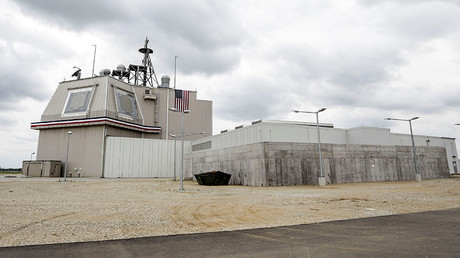“We have been following closely the ongoing discussion in Japan over several years about the possibility of buying advanced missile defense systems from the US,” Russian Foreign Ministry spokeswoman Maria Zakharova said on Thursday, as cited by TASS.
“Of course, we saw recent media reports that Japan’s Defense Ministry is leaning towards choosing the Aegis Ashore systems.
“From the very beginning, we clearly exposed our concerns over plans to Tokyo, pointing to the failure of the Japanese side’s attempts to justify those plans by progress in the DPRK’s [the Democratic People’s Republic of Korea’s] nuclear missile programs,” she said.
The Aegis Ballistic Missile Defense System (ABMD) is designed to provide defense from short to intermediate-range missiles and consists of BMD-capable ships as well as a ground-based configuration. Japan’s Defense Ministry “decided to consider introducing a new US-made missile defense system known as ‘Aegis Ashore’ in light of progress in North Korea’s missile development,” NHK reported last Thursday.
Two or three Aegis Ashore batteries would be needed to defend the whole of Japan, at a cost of 70 to 80 billion yen (US$638.5 million to $726.6 million) per battery, Japanese daily the Mainichi reported last week.
“It is obvious to us that the decision to purchase and deploy the new [Aegis Ashore] systems, if it is taken, should be considered as disproportionate to real missile threats in the region. It [the decision] is capable of undermining the stability in the North Pacific Ocean, given the eventual incorporation of this system into the military infrastructure of the Asian segment of the global US missile defense system,” the Russian Foreign Ministry spokeswoman concluded.
Japanese Defense Ministry officials told Kyodo news earlier this month that Tokyo was considering the deployment of the Patriot Advanced Capability-3 (PAC-3) system at ground Self-Defense Force bases in the western prefectures of Shimane, Hiroshima and Kochi – areas which North Korea said its missiles could fly over.
Japan’s missile defense program currently includes the Maritime Self-Defense Force’s (SDF) Aegis destroyers, aimed at shooting down airborne missiles, and the Air Self-Defense Force’s PAC-3 system, which is aimed at countering missiles that evade Aegis interceptors.
Aegis Ashore uses the same components that are currently deployed on the country’s Aegis destroyers. The difference is that the system is land-based.
Japan also hopes to increase its number of Aegis-equipped destroyers from four to five by the end of the year, NHK reported. In addition, it reportedly plans to develop an anti-stealth radar system which could locate ballistic missiles with stealth capabilities.
Japan has also been flexing its muscles with the US, including joint air maneuvers when US supersonic B-1B Lancer bombers joined by Japanese and South Korean fighter jets performed flights over the Korean Peninsula.
North Korea has conducted several missile tests in recent months that run contrary to UN resolutions. Pyongyang added fuel to the fire when it announced that it was developing a plan to strike Guam, which would include missiles passing over Japanese territory.
That came shortly after US President Donald Trump warned Pyongyang of “fire and fury” if its threats continued. Pyongyang later said it was ready to put off its Guam plan, urging Washington to refrain from threats against North Korea. Trump described the move as a “wise” decision.
US-S. Korea drills further escalate tensions
Pyongyang, in turn, voiced concerns over annual US-South Korea military drills, the Ulchi Freedom Guardian exercises, describing the war games as an “explicit expression of hostility.”
The 2017 version of the war games are taking place between August 21 and 31.
The Russian Foreign Ministry spokeswoman pointed out on Thursday that the US-South Korean joint drills do not contribute to de-escalation on the Korean Peninsula.
“We call on all parties to use the utmost caution,” the diplomat said.
“As a result of pumping the region with weapons, any reckless move or even an unintentional incident may serve as a pretext for military conflict,” she warned.
Russian Tu-95MS strategic bombers carried out routine flights over international waters in the Sea of Japan, and the Yellow and East China Seas, the Russian Defense Ministry said on Thursday.
The long-range planes were accompanied by Su-35S fighters and A-50 airborne early warning and control aircraft, according to the ministry.
“During parts of the route, Russian strategic bombers were escorted by South Korean and Japanese military jets,” the ministry added.
“In accordance with an approved plan, long-range aviation pilots routinely fly over neutral waters of the Atlantic, Arctic, Black Sea, Pacific, both from base and operational aerodromes. All aircraft flights are carried out in strict accordance with the International Rules for the Use of Airspace over Neutral Waters, without violating the boundaries of other states,” the Russian Defense Ministry noted.
Source Article from https://www.rt.com/news/400753-japan-aegis-system-russia/?utm_source=rss&utm_medium=rss&utm_campaign=RSS
Related posts:
Views: 0
 RSS Feed
RSS Feed

















 August 24th, 2017
August 24th, 2017  Awake Goy
Awake Goy 


 Posted in
Posted in  Tags:
Tags: 
















